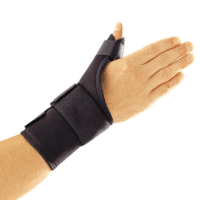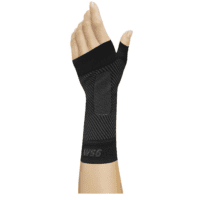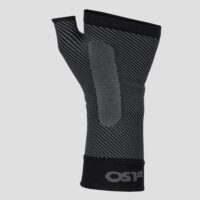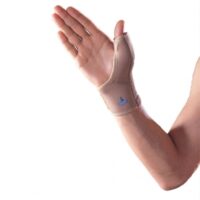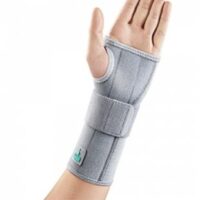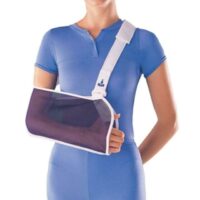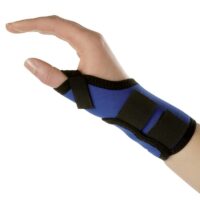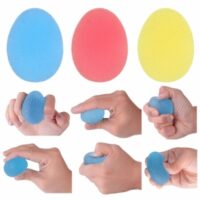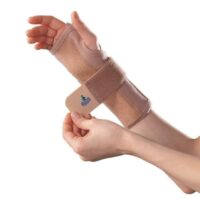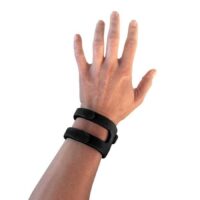
De Quervains Tenosynovitis
What is De Quervains Tenosynovitis?
De Quervains tenosynovitis, a common wrist and thumb condition, primarily affects the abductor pollicis longus (APL) and extensor pollicis brevis (EPB) tendons. These tendons pass through a tunnel near the radius bone’s end in the forearm, lined with a slippery substance called tenosynovium. Inflammation or thickening in this area leads to pain and limited movement.
What is the Cause of de Quervain’s Tenosynovitis?
This condition often stems from repetitive occupational hand and thumb movements, such as pinching, grasping, or wringing. These actions can inflame the tenosynovium and tendons, leading to swelling and restricted movement. Injury-induced scar tissue, rheumatoid arthritis, hormonal changes, and certain conditions like diabetes and thyroid disease also contribute to its development.
Recognising Symptoms
The initial symptom is soreness on the thumb side of the forearm, near the wrist. Untreated, it can spread up the forearm or down into the wrist and thumb. Swelling, a creaking noise (crepitus) during tendon movement, and difficulty in grasping are common signs. A lump at the thumb’s base may also form.
Diagnosis Techniques
Diagnosis primarily relies on symptoms and a physical exam. The Finkelstein test is a key diagnostic tool, best performed by a healthcare professional. Imaging is typically unnecessary.
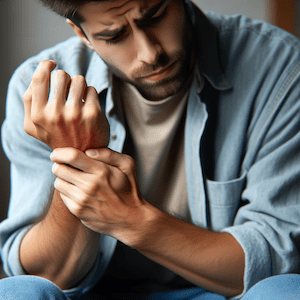
What is the Best Treatment for de Quervain’s Tenosynovitis?
Treatment includes rest, splinting, physiotherapy, and possibly glucocorticoid injections.
Rest and Movement Modification:
Avoiding painful activities and maintaining neutral wrist alignment are crucial.
Thumb-Spica Splint:
This helps immobilise the wrist and thumb, aiding in healing. View splints here: Thumb-Spica Splint
Glucocorticoid Injections:
These can provide relief, especially when combined with splinting.
Physiotherapy:
Focuses on reducing tendon irritation. This includes ergonomic advice, ice packs, soft-tissue massage, stretching, and strengthening exercises. Therapists also suggest changes in work or activity techniques to reduce stress on the thumb and wrist.
Will de Quervain’s Tenosynovitis Go Away on its Own?
New Research and Developments
Recent advancements in physiotherapy emphasise the importance of early intervention and customised treatment plans. Techniques like ergonomic analysis and targeted exercises have shown promising results in speeding up recovery and reducing recurrence rates. Additionally, ongoing research is exploring the role of diet and supplements in managing inflammation and promoting tendon health.
What to Do? Seek Professional Advice
If you suspect you have De Quervains tenosynovitis, consult a physiotherapist or doctor. They will assess your condition, suggest appropriate treatments, and guide you through a personalised recovery plan. Remember, early diagnosis and tailored care are key to effective recovery and preventing long-term issues.
Conclusion
De Quervains tenosynovitis, while painful, is highly treatable with the right approach. Understanding the condition, early intervention, and following a physiotherapist’s guidance are vital for a quick and successful recovery. By adjusting daily habits and incorporating specific exercises, you can manage symptoms and prevent future occurrences. Stay informed, stay active, and don’t hesitate to seek professional advice for optimal wrist and thumb health.
For specific advice regarding your de Quervain’s tenosynovitis, please consult your hand physiotherapist or doctor.
Related Articles
- Thumb Pain: Offers information on causes and treatment of thumb pain, closely related to De Quervains Tenosynovitis.
- Hand & Wrist Injuries: Provides a comprehensive overview of common hand and wrist injuries, including symptoms and treatments.
- Repetitive Strain Injury (RSI): Discusses RSI, a condition related to repetitive hand and wrist movements, much like De Quervains Tenosynovitis.
- Rheumatoid Arthritis: Explores rheumatoid arthritis, a condition mentioned as a contributing factor to De Quervains Tenosynovitis.
- Ergonomic Assessments: Explains ergonomic assessments which can help prevent conditions like De Quervains Tenosynovitis.
- Physiotherapy Treatments: Outlines various physiotherapy treatments, relevant for De Quervains Tenosynovitis recovery.
Article by John Miller
Common Wrist & Hand Pain or Injuries


Wrist and hand pain can significantly impact daily life, limiting your ability to perform simple tasks. In this article, we explore the common causes of wrist and hand pain, various injuries, and effective treatment options from a physiotherapist's perspective.
Traumatic Injuries
Traumatic injuries such as broken wrists, finger sprains, and thumb sprains are common causes of wrist and hand pain. These injuries often result from falls, accidents, or direct impacts. They cause immediate pain, swelling, and difficulty in moving the affected area.
Overuse Injuries
Overuse injuries occur due to repetitive motions or prolonged strain on the wrist and hand. Common overuse injuries include carpal tunnel syndrome, de Quervain’s tenosynovitis, and repetitive strain injury (RSI). These conditions often result in pain, numbness, and tingling sensations.
- Carpal Tunnel Syndrome
- de Quervain's Tenosynovitis
- Muscle Strain
- Overuse Injuries
- RSI - Repetitive Strain Injury
- Wrist Tendinopathy
Degenerative or Systemic Conditions
Conditions such as arthritis and rheumatoid arthritis can cause chronic wrist and hand pain. These conditions are typically progressive, leading to persistent pain, stiffness, and swelling in the joints.
Treatment Options for Wrist & Hand Pain
Physiotherapy offers a range of effective treatments for managing wrist and hand pain. Here are some common treatment approaches:
- General Management and Early Injury Treatment
Early intervention is crucial for managing wrist and hand injuries. Avoiding harmful activities, applying ice, and resting the affected area can prevent further damage. - Ergonomics
Proper ergonomics can reduce the risk of overuse injuries. An online workstation assessment can help identify and correct poor ergonomic practices that contribute to wrist and hand pain. - Joint Mobilisation Techniques
Physiotherapists use joint mobilisation techniques to improve joint movement and reduce pain. Physiotherapy instrument mobilisation (PIM) is a specialised technique that can effectively target stiff joints. - Muscle Treatment
Soft tissue massage and strength exercises can alleviate muscle tension and improve function. These treatments help restore normal movement patterns and reduce pain. - Support & Protection
Wrist braces, supportive taping, and kinesiology tape can provide stability to injured areas, preventing further strain and promoting healing. - Pain Relief Approaches
Acupuncture, dry needling, electrotherapy, and local modalities like heat packs and TENS machines can offer significant pain relief. These methods help manage pain and promote recovery.
Conclusion
Wrist and hand pain can stem from various causes, including traumatic injuries, overuse, and degenerative conditions. Effective management through physiotherapy can significantly improve your quality of life. Remember, early intervention and proper treatment are crucial in preventing long-term issues.
What to Do?
If you experience wrist and hand pain, seek the professional advice of your physiotherapist. They can provide a personalised treatment plan to address your specific needs and help you return to your daily activities pain-free.
Wrist & Hand Pain FAQs
- What are the common causes of wrist and hand pain? Wrist and hand pain can result from traumatic injuries, overuse conditions, and degenerative diseases like arthritis.
- How can carpal tunnel syndrome be treated? Carpal tunnel syndrome can be managed with physiotherapy, ergonomic adjustments, wrist braces, and sometimes surgical intervention.
- What are the symptoms of de Quervain’s tenosynovitis? Symptoms include pain and swelling near the base of the thumb, difficulty gripping, and a catching or snapping sensation when moving the thumb.
- How does physiotherapy help with wrist and hand pain? Physiotherapy offers treatments like joint mobilisation, muscle strengthening, and pain relief techniques to improve function and reduce pain.
- When should I see a physiotherapist for wrist and hand pain? If you experience persistent pain, swelling, or difficulty in movement, it is advisable to consult a physiotherapist for a proper assessment and treatment plan.
- Can ergonomic changes reduce wrist and hand pain? Yes, proper ergonomic practices can significantly reduce the risk of developing overuse injuries and alleviate existing pain.
Related Articles
- Ergonomics and Your Workstation
Discover how proper ergonomics can prevent wrist and hand pain. - Managing Carpal Tunnel Syndrome
Learn about effective treatments for carpal tunnel syndrome. - Understanding de Quervain’s Tenosynovitis
Find out the causes and treatments for de Quervain’s tenosynovitis. - Physiotherapy for Arthritis
Explore how physiotherapy can help manage arthritis pain. - Effective Use of Wrist Braces
Understand the benefits of wrist braces for support and pain relief. - The Role of Strength Exercises in Pain Management
Discover how strength exercises can alleviate wrist and hand pain. - Benefits of Acupuncture and Dry Needling
Learn how acupuncture and dry needling can provide pain relief. - Electrotherapy for Pain Management
Find out how electrotherapy can help manage wrist and hand pain. - Understanding Repetitive Strain Injury (RSI)
Get insights into the causes and treatments for RSI. - Joint Mobilisation Techniques in Physiotherapy
Learn about various joint mobilisation techniques used in physiotherapy.
Common Wrist & Hand Pain Treatments
General Management
- Early Injury Treatment
- Avoid the HARM Factors
- What to do after a Muscle Strain or Ligament Sprain?
- Sub-Acute Soft Tissue Injury Treatment
- Ergonomics
- Online Workstation Assessment












